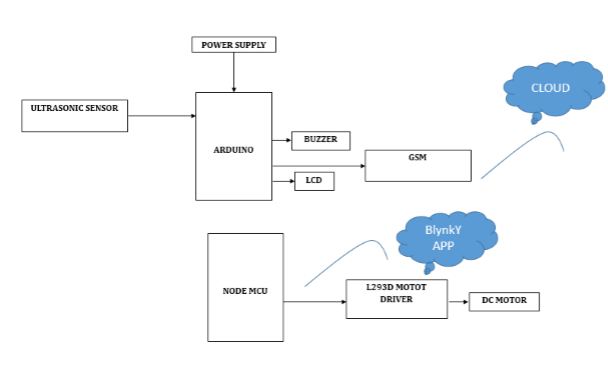Automated Fluid Level Sensing and Controlling System Using IoT
Objective
The main objective of this project is to measure the Fluid level in Borewells, tanks etc. to assist and alert everyone
Abstract
One of the topic which is growing very popular now a day’s is Fluid Level Management System In IOT. Because it has a various advantages so that people can do their work very easily and effectively. Fluid level management system refers to the monitoring and controlling the level of water inside the tank, bore-wells, river, ponds, industrial areas, and other water streams, and the liquid inside the container. The growth of Internet of Things (IOT) paved the significant attention in all fields. In this paper we are also discussing the wide ranging fluid level control and managing techniques with central controller based ARDUINO with the cloud based techniques, SMS, and the internet performance with GSM modules with monitoring fluid levels on LCD as well as on App or server. To achieve the objective cloud database technique is maintained which encapsulate the periodic monitoring water level data and vicinity information. The sensor data is collected periodically that are uploaded to the cloud database where the automatic comparison analytics about the increase in water level is noted. Thus, the prior stages of rise in fluid level are automatically alerted to the public respectively. Finally, it was observed that the level of accuracy is grown by this technique in comparison with ordinary method of monitoring and alerting system.
Keywords: Arduino, Internet of Things, ultrasonic sensor, fluid level.
NOTE: Without the concern of our team, please don't submit to the college. This Abstract varies based on student requirements.
Block Diagram

Specifications
Hardware Requirements:
- Arduino
- Ultra sonic Sensor
- DC motor
- Motor driver
- LCD
- 4-Bit PCB with Potentiometer
- Transformer
- Power Supply
- Buzzer
- Node MCU
- GSM
Software Requirements:
- Arduino IDE
- Embedded C
- Third Party Server
- Blynk app
Learning Outcomes
- What is Node MCU?
- How Node MCU works?
- What is buzzer?
- How to interface buzzer with Arduino?
- What is LCD?
- How to interface LCD with Arduino?
- What is ultra-sonic sensor?
- How to interface ultra-sonic sensor with Arduino?
- How to interface GSM with Arduino?
- What is motor driver?
- How to interface motor driver with Node MCU?
- What is DC motor?
- What is thingspeak?
- What is IFTTT service?
- What is Transformer?
- How Transformer works?
- What is Power Supply?
- How Power Supply works?
- About Project Development Life Cycle:
- Planning and Requirement Gathering( software’s, Tools, Hardware components, etc.,)
- Schematic preparation
- Code development and debugging
- Hardware development and debugging
- Development of the Project and Output testing
- Practical exposure to:
- Hardware and software tools. ,
- Solution providing for real time problems,
- Working with team/ individual,
- Work on Creative ideas.
- Project development Skills
- Problem analyzing skills
- Problem solving skills
- Creativity and imaginary skills
- Programming skills
- Deployment
- Testing skills
- Debugging skills
- Project presentation skills
- Thesis writing skills





 Paper Publishing
Paper Publishing
